Most people are aware of the honeybee crisis, but honeybees aren’t the only ones in trouble. Other pollinators are also in decline. Since becoming aware of the honeybee crisis, researchers have put more emphasis into studying all pollinators. They have learned that native bees not only pollinate crops alongside honeybees, but also improve the efficiency of honeybee pollination. And some native bee species are even more efficient at pollinating than honeybees.
Nurturing a garden habitat for native bees gives them a place in which to live, eat and raise their young. Creating a habitat for bees is creating a wildlife habitat for all, because it attracts other wildlife, such as butterflies, birds, hummingbirds and other insects. See how and why you should design your garden for native bees below.
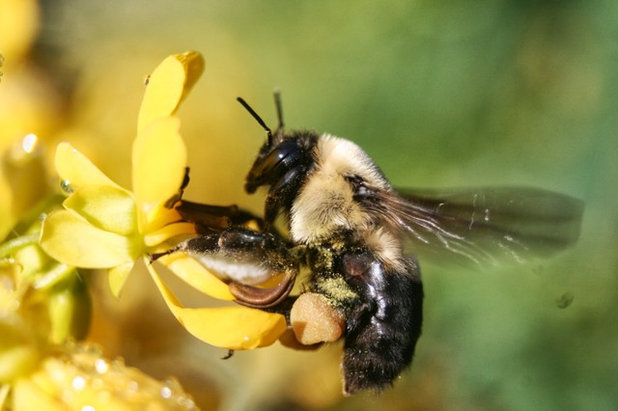
Benjamin Vogt / Monarch Gardens
Why should I care about pollinators? Pollinators provide important services to us and the ecosystem. Bees, birds and bats pollinate more than a third of our crops. From our morning coffee and evening wine to our lunchtime pear and sandwich mustard, the foods on our table owe their existence to pollinators. Most pollinators are insects. Butterflies, moths, beetles, European honeybees, native bees and even flies and wasps are all part of the parade of insects that pollinate our homegrown vegetables, our orchards of apples and other flowering plants around the globe.
What can I do for pollinators? Pesticides, habitat loss, habitat fragmentation and habitat degradation have had the largest negative impact on pollinators. We can help by simply providing a pesticide-free habitat. Any home gardener, with even the smallest garden, can make a difference. Besides, it’s great fun.
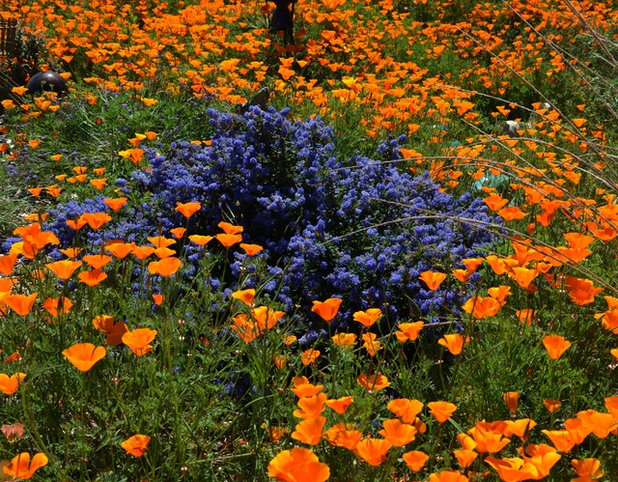
Pete Veilleux, East Bay Wilds
Features of a Native Bee Habitat1. Diversity with blocks of color. This large block of orange California poppies (
Eschscholzia californica) with another large block of deep blue ceanothus will attract native bees better than a few of each plant placed here and there.
The Xerces Society promotes planting a diversity of flowering plants for pollinators in large blocks of color. Like a flashing neon light, diverse plants in blocks point all the pollinators to the party. The Xerces Society says to provide:
- Several different plant species flowering at the same time
- A combination of flowering annuals and perennials
- Flowers of different sizes, shapes and colors
- Blocks of color: patches of about 3½ feet by 3½ feet of a single plant species and flower color
- Year-round food: flowering plants in all growing seasons
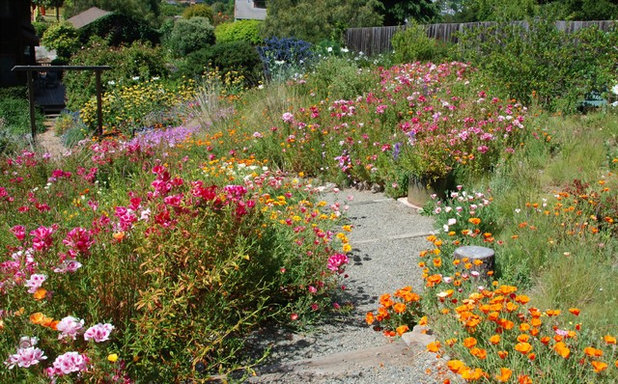
Pete Veilleux, East Bay Wilds
Many of our home gardens can’t have that much diversity, but you’d be surprised how many pollinators you can support in a small space. Do what you can with the space you have. This new garden has been designed so these
Clarkia and poppy (
Eschscholzia californica) annuals will be replaced by flowering perennials as the year progresses. As the garden matures, some of the annuals and perennials will be replaced by flowering trees and shrubs.
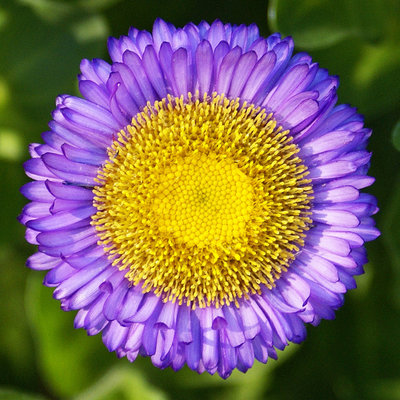
Debbie Ballentine
2. Native plants for native bees. The UC Berkeley Urban Bee Lab has been studying native bees and their food choices over the past decade. Through The Urban California Native Bee Survey, the researchers discovered that local native bees prefer local native plants over nonnative ones four to one. This isn’t surprising when you think about the millennia that insects and plants have been evolving together.
Native bees need both nectar (carbohydrates) and pollen (protein) to feed themselves and their young. Some plants provide one or the other, while plants in the aster family, such as Pacific aster (
Symphyotrichum chilense), provide both pollen and nectar.
In my opinion, the aster family is the single most important family of plants for insects, not only for the one-two punch of pollen and nectar but also because the central “disk” of each flower is actually many flowers. Here you can see the many flowers on the central disk of a
seaside daisy (
Erigeron glaucus). This disk provides pollinators with a high concentration of food on a single landing pad.
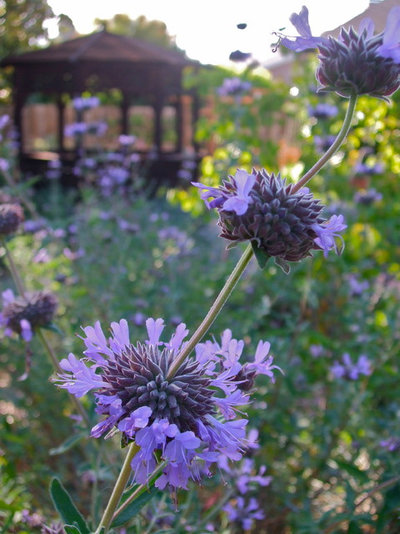
Edger Landscape Design
Along with plants in the aster family, many native species of buckwheat (
Eriogonum spp), sage (like Cleveland sage,
Salvia clevelandii,
shown)
, California lilac (
Ceanothus spp) and manzanita (
Arctostaphylos spp) are prized by native bees in California.
The U.C. Berkeley Urban Bee Lab website has a list of the best bee plants for California, including native and nonnative plant species, organized by spring and summer. Gordon Frankie of UC Berkeley published an exciting new book this month,
California Bees and Blooms: A Guide for Gardeners and Naturalists, which describes in detail the plants that California native bees find most irresistible.
No matter where you live: How to Find the Right Native Plants for Your Yard
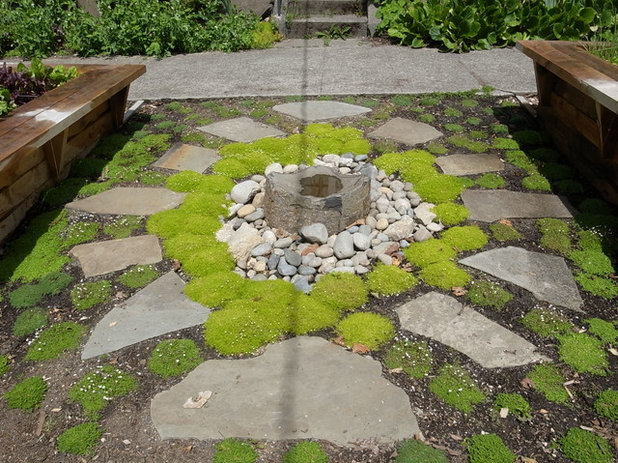
Erin Lau Landscape Design- Seattle
3. Water. All creatures need water. There are many options for offering water to insects. Something as simple as a birdbath provides enough water for birds and insects alike. Ponds and recirculating fountains can be a lovely focal point in a garden design as well as provide habitat. Be sure to follow your local water company’s guidelines for water usage. All water features require that you replenish the water every few days or recirculate the water through a pump, to eliminate mosquito larvae.
Insects also feed on the minerals and salts in soil; a small to moderate puddle of muddy water in a large bowl or garbage can lid under the soil is an easy way to give them additional nutrients.
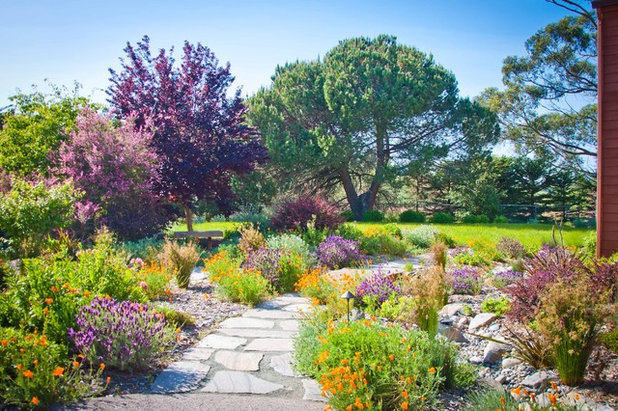
Sage Ecological Landscapes and Nursery
4. Full sun. Insects are cold-blooded, so they need the warmth of the sun to move around. Like our morning coffee, a sunny garden gives insects the boost they need to wake up and get going for the day.
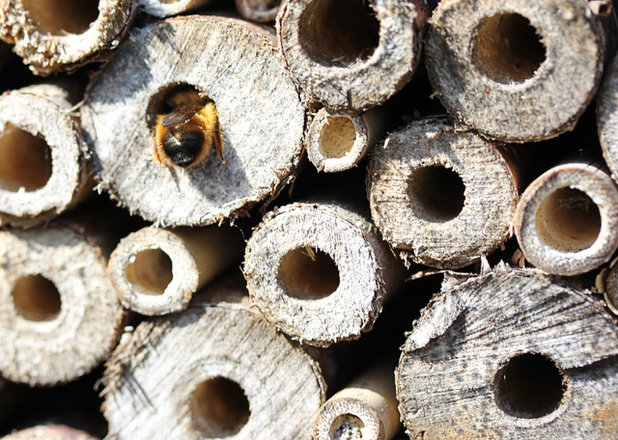 5. Cover and places to raise young.
5. Cover and places to raise young. Whether simple or complex, homemade or store bought, bee hotels — also called bee nests and bee boxes — like the one shown here offer additional space where female bees can lay their eggs.
Unlike European honeybees, which live in groups inside hives, most native bees live alone in the ground. Ground-nesting native bees dig holes in the ground or use vacated holes for their nests. Other bee species use plant material and holes in wood. Ground-nesting bees don’t like to wade through layers of mulch. Be sure to leave sunny areas with bare dirt in your garden for bees to make their homes in.
See how to build your own bug boxes
Photo by Flickr user echoe69
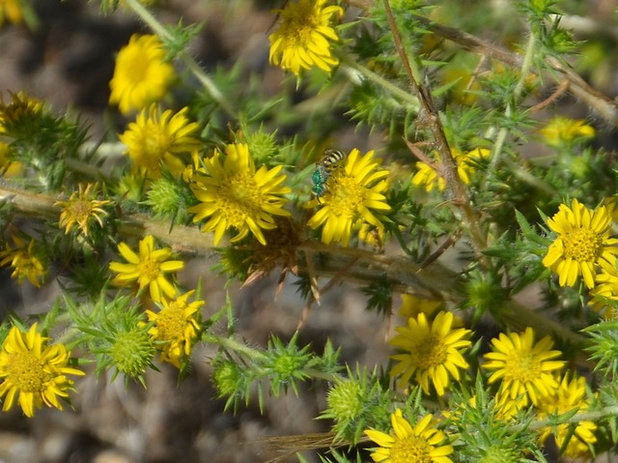
Treebeard
6. No “cides.” Pesticides, herbicides and other “cides” are toxic to wildlife in general and particularly to insects. What pesticide companies don’t want you to know is that the good bugs know how to find the bad bugs. Between the distress signals that the plant sends out and the chemical signature of the bad bugs’ poop, the advertisement clearly says, “Dinner’s here!” This allows the good bugs to target and destroy bad bugs relatively quickly. So be patient. Accept some nibbles on plants. Who knows, it might just be a leafcutter bee that took a bit of your western redbud (
Cercis occidentalis) to soften its nest.
The use of pesticides disrupts the natural cycle. I’ve found that if I leave the bad bugs, then the good bugs will come. If the bad bugs get completely out of control and the health of a plant is at risk, a water sprayer or homemade nontoxic concoction can reduce their population. In six years of native plant gardening, I’ve needed to do thisonly for seasonal outbreaks of lace bugs on a Toyon (
Heteromeles arbutifolia).
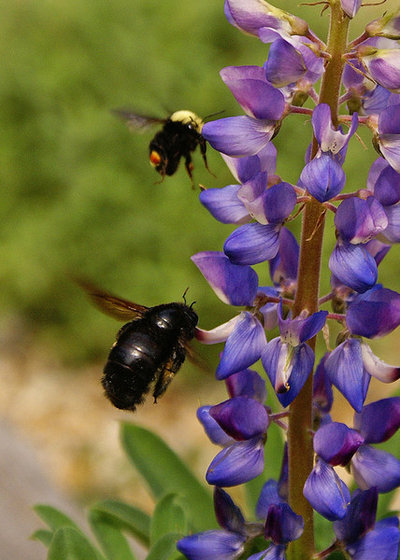
Debbie Ballentine
The six basic elements of gardening for native bees are simple. The pleasures and rewards are enormous. Now go out and make your own little habitat and watch the daffy fanfare of pollinators as they make their homes, provide for their young, feed on your flowers and put on a great show.
Resources on native bees:- The UC Berkeley Urban Bee Lab — a wealth of information on gardening for California native bees
- California Bees and Blooms: A Guide for Gardeners and Naturalists, by Gordon W. Frankie, Robbin W. Thorp, Rollin E. Coville and Barbara Ertte
- Attracting Native Pollinators: Protecting North America’s Bees and Butterflies, by the Xerces Society
- Field Guide to the Common Bees of California, by Gretchen LeBuhn
- Pollinator-Friendly Parks: How to Enhance Parks, Gardens, and Other Greenspaces for Native Pollinator Insects, by Matthew Shepherd, Mace Vaughan and Scott Hoffman Black
- The USDA website’s article “Honey Bees and Colony Collapse Disorder” provides the latest information about the honey bee crisis.
More: Gardening for the Bees, and Why It’s a Good Thing





